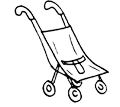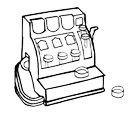10 facts you didn't know about breastfeeding around the world
How do you breastfeed in Tokyo or southern Africa? Which country is the world champion in lactation? How do governments encourage breastfeeding for working mothers? A world tour of surprising facts on breastfeeding.
Naturally, we say to ourselves that there is nothing easier than breastfeeding. A baby, a breast and that's it! And yet ... if nature has given all women in the world the power to breastfeed, the practice is far from universal.
It is estimated that only 40% of babies are breastfed worldwide. Beliefs, traditions, l'activity and status of mothers influence breastfeeding choices from one culture to another.
1. In Japan, breast-feeding is carried out l'out of sight in breast-feeding cubicles
Cover this breast that I cannot see! said Molière. Well, the mood remains the same 4 centuries later and almost 10,000 kilometers away.
It's true that l'inventiveness in the land of the Rising Sun is well established: we've heard of women-only subway trains and the bra that allows daddy to breastfeed. Now there are breastfeeding booths.
Even if modesty is de rigueur in Japanese culture, breastfeeding is strongly encouraged. In fact, although the Japanese population has the lowest birth rate in the world (1.36 children per woman), breastfeeding mothers are by no means left out in the cold.
In l'public space in some cities, there are "jyunyuu-shitsu jyunyuu-shitsu "available to women and their offspring. These sare equipped breastfeeding areas, strictly off-limits to men. They enable mothers to quell their baby's cravings in complete tranquillity. And to top it all off, the most modest can even opt for an individual cabin.
2. In Mongolia, people consume breast milk... at any age
While here at home, the concept may stir the heart (sorry if you're passing by), there are places on earth where l'they've understood the potential of breast milk.
In Mongolia, milk is considered so healthy that even adults occasionally taste it. Mongolians love it; it almost reminds us of lObelix's love of magic potion.
Mothers often reserve some of their milk for the rest of the family. It is also common to use this breast milk for therapeutic purposes, especially for the elderly. This is also the case in China, where convalescents consume it to recover.
Unsurprisingly, practices sometimes go awry. And it hasn't failed! The Japanese capital recently saw open the world's first breast-milk bar. How cool is that ? You can drink milk by the glass or directly from the breast... WHAT ?!Alas, its location in the heart of Tokyo's red light district and its exclusively male clientele leave no doubt as to its erotic rather than therapeutic purpose.
3. In the Muslim culture, the Tahnîk is practiced
To whet your appetite, many Muslim families practice Tahnîk. This tradition l'involves applying the pulp of a date to the roof of a newborn's mouth with the finger before the first feed.
If l'you don't have a date on hand, any sweet food will do l'the trick. Lhe aim is to prepare l l 's stomach to receive breast milk.
Recently, the benefits of this practice have been proven by researchers at l'University of Auckland in Australia, thanks to their study The Sugar Babies Study. LThe experiment was carried out in maternity wards, with a sample of infants, using ldextrose gel.
Their findings? The process could reduce l'hypoglycemia in babies. "Dextrose gel is expected to become a leading treatment for the management of l'hypoglycemia in late preterm and full-term babies within 48 hours of birth", states the report. A custom to be copied without further delay!
4. In Indonesia, the working mums have their milk delivered by courier
At l'era of Deliveroo and other Uber Eats, Indonesian babies also have their own food delivery service.
As we all know, the duration of breastfeeding too often depends on the length of maternity leave. After a few months, when mothers have to go back to work, babies are often taken away from their mother's breast. Yet l'World Health Organization (WHO ) recommends lexclusive breastfeeding for the first 6 months, then alternating with other foods until at least 2 years of age.
Unfortunately, Mother Nature has made it difficult, if not impossible, to get enough milk each morning to meet the daily needs of our offspring. So what to do?
Indonesian company Arga Nirwana Express has found THE unstoppable solution for working mums delivery of breast milk. Real genius! Since 2005, couriers have been going to moms' workplaces to collect freshly pumped milk, then delivering it to nannies, keeping it fresh and cool. keeping it cool.
This initiative is made possible by the fact that in Indonesia, companies are lobliged to offer a lactation room. In between meetings, women can bottle-feed their precious elixir.
5. In India, babies are only breastfed after one month
Colostrum is a yellowish, whey-like liquid that emanates from the nipples after the childbirth. In many Asian countries, including l'India, colostrum is thought to be impure, or even toxic. A false belief, however, deeply rooted in Indian culture. And that's a shame, because colostrum is extremely nutritious for infants, being rich in proteins, vitamins, minerals and anti-infectives. In short, everything a baby needs.
But in the land of l'Hinduism, we don't give it to babies. Instead, they are fed infant milk for the first few days of their lives, until their milk comes in and they can be put to the breast.
This does not, however, reflect a lack of interest on the part of Indian women in breastfeeding. In fact, while it is estimated that only 35% of infants in India are breastfed after 48 hours, over 94% are breastfed after 1 month. Well done!
6. In the U.S., it's only been legal to breastfeed in public since 2018
It sounds like a sick joke, but it's not l... We had to wait until 2018 not to risk being arrested, toddler at breast, in l'public space in some American states. No Joke!
In July 2018, and after a long legal battle, Idaho and Utah finally passed a law making it legal to feed your baby in public. #Hallelujah It was the last 2 of 50 North American states to consider the practice illegal.
Related or not to this decision, the number of breastfed babies in the United States continues to grow. In 2018, 84% of them were breastfed - compared to 77% in Belgium or even 70% in France.
7. The Kung San of South Africa breastfeed up to 100 times a day
And here, admit that like us, you do your math: 100 times a day divided by 24H = ?
Cultural variations in breastfeeding practices also include the frequency of suckling. In southern Africa, the !Kung San of the Kalahari desert are an indigenous people who lcan be described as modern hunter-gatherers.
In this community, newborns and infants are breastfed (very) frequently and intensively. On average, they are fed every 15 minutes (or 4 times an hour, if you've done the math right). And that's at least until l's 2nd birthday. In short, mothers spend all their time with their little ones, who are perpetually perched in their arms or in those of another member of the community.
More surprisingly, children are never put on the floor because the Kungs believe that it is detrimental to their development.

Your back and chest chest aches just reading these lines, keepin mind lthat the !Kung way of life is very different from that of our modern society. The mother receives a lot of help and is never alone. The African proverb: "It takes a village to educate a child" takes on its full meaning here.
8. In Bangladesh, we support breastfeeding in the workplace
The Mothers@Work program was launched in 2017 at l'initiative of the UNICEF and Better Work Bangladesh (BWB). It's a national initiative that aims to protect mothers and ensure their children receive the nutrients essential for their healthy development.
This initiative has been rolled out in 92 partner factories, which s s have committed to providing mothers with a fully-equipped breastfeeding room and a day-care center. Mothers also benefit from 2 extra 30-minute breaks a day to spend more time with their little ones.
Sounds like a dream? But that's not all! A medical team is also on hand to advise mothers on maternity care and raise awareness of the benefits of advantages of breastfeeding.
Not surprisingly, Mothers@Work benefits working women, their babies and also employers, as a happy mother is a more productive employee.
So don't hesitate to forward this article to your bosses... #derien
9. The Philippines holds the world record for l'simultaneous breastfeeding
The Guinness Book of Records says it all: in 2007, over 15,200 women simultaneously breastfed their babies throughout the Philippines. This sis a world record which, unless we're mistaken, has yet to be broken.
The challenge may make you smile, but the motivation is noble: the public authorities want to promote breastfeeding to the detriment of industrial milk.
Indeed, the Philippines is known for its unparalleled support for nursing mothers. Thanks to the Milk Codethe country has banned all marketing of infant milk (advertising, distribution of samples, discounts, etc.) for 25 years. Violators can even be imprisoned.
A model student, the country also strengthened its support for young mothers in 2009 with a law requiring public facilities to offer lactation stations that must be equipped with comfortable seats, sinks, electrical outlets for breast pumps and refrigerators. The minimum, we think!
10. In Brazil, donations are made to the world's largest milk bank
The suspense is over! The world champions in breastfeeding are indeed the Brazilians. It is estimated that nearly 95% of their babies are breastfed.
However, 11% of births in the country are to premature babies. The favelaswhere the poorest social classes live, are the most affected by the phenomenon.
Faced with poverty and l'urgency, thousands of mothers donate every year to the world's largest breastmilk bank: l'Institut Fernandes Figueira. Although the Institute receives funding from the Ministry of Health, l's main activity relies on the solidarity of mothers. Real heroines sometimes draw up to 2 liters of milk a week, in addition to that intended for their children.
It's the firefighters who graciously take care of transferring the milk to the bank. As breast milk acts like a medicine on these newborns, it is estimated that these donations save 170,000 premature babies every year.
In conclusion, despite cultural disparities, the world seems convinced that breastfeeding is healthy! In fact, initiatives are springing up on every continent, with the common goal of lincreasing the number of babies being breastfed. This is encouraging, because if the practice becomes widespread, it could save more than 800,000 newborn babies every year.
Carole Bertrand, for Milk Away
#milkawayapparel #inmumwetrust #breasfeeding #breastfeedingmom #breastfeedingjourney
Sources:
- Expatica - expatica.com
- Frenchy nippon - frenchynippon.com
- Lactation matters - lactationmatters.org
- La leche league international (LLLI) - llli.org
- World Health Organization (WHO) - www.who.int
- Oummi Materne - oummi-materne.com
- The world - theworld.org
- The science of mom - scienceofmom.com
- UNICEF - unicef.org
- Breastfeeding: Biocultural Perspectives - Patricia Stuart-Macadam
- Breastfeeding Among U.S. Children Born 2011-2018, CDC National Immunization Survey - CDC.gov
photo credit: Unsplash - Mehmet Turgut Kirkgoz





